Blog
Are you curious about tips & tricks or more important information about your dog or cat? Then you have come to the right place. Discover here everything from A to Z that you need to know for your pet. Subscribe to our newsletter and stay informed about our latest monthly blogs.
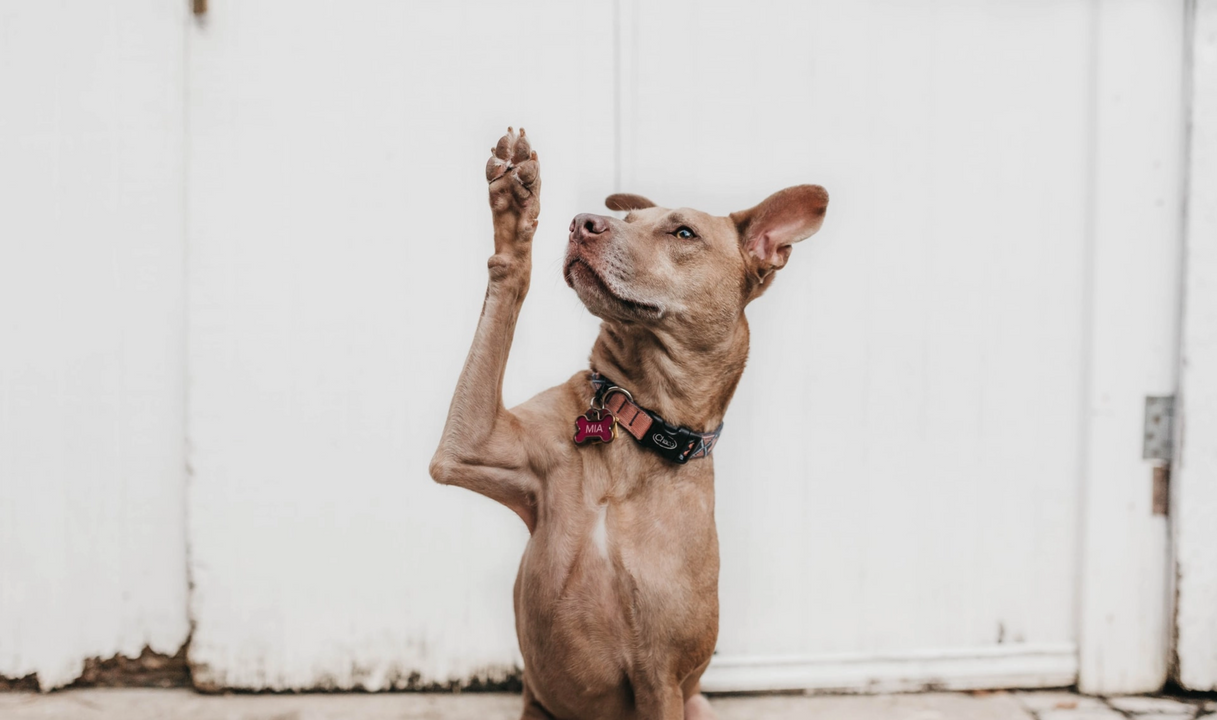
Blog
Are you curious about tips & tricks or more important information about your dog or cat? Then you have come to the right place. Discover here everything from A to Z that you need to know for your pet. Subscribe to our newsletter and stay informed about our latest monthly blogs.

ALL ARTICLES
DOGS
CATS
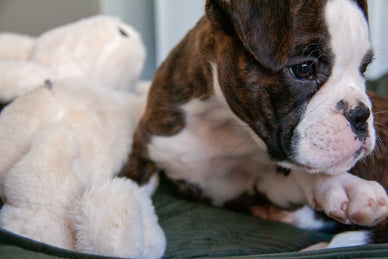
Potty training your puppy
Puppies already learn a lot of "manners" from their mothers but once the puppy arrives at your home, it is your responsibility to raise this puppy correctly. One of the first training sessions during this education will be the toilet training.
From the word alone, many go berserk. Potty training, so crucial but where and how to start? Well, let us help you. Complete potty training usually takes 6 to 10 weeks. With the following tips you will get your puppy fully housebroken in no time. Peeing in the house will be completely a thing of the past.
Be vigilant
One of the most important aspects of potty training is watchfulness over your puppy. Always keep an eye on him. As soon as you notice a change in his behavior, let him out.
Hou een vaste routine aan
Honden zijn gewoontedieren en hechten veel belang aan routine, begin dus met het opstellen van een dagschema. Neem de pup dagelijks op dezelfde momenten mee naar buiten om hun behoefte te doen, zoals bv. nadat ze gegeten hebben, nadat ze wakker worden, voordat ze in de bench moeten en opgelet als ze rondsnuffelen opzoek naar een plek, dan is het zeker het moment om de pup buiten te plaatsen. Na verloop van tijd zal je de signalen die je pup je geeft beginnen opmerken.---article-upsell-here---
Choose a fixed place in the garden
Provide your pup with a fixed place to do his business in the garden. Praise your pup to the skies, so to speak, after he has done his business in his regular spot. A treat will also encourage the pup to do his business in the right place next time.
Every time your pup gets ready to do his business in the right place, link this to the same word or command, such as "do a pee". If you also include this in the routine, your dog will understand faster what you want from him.
Punishment is counterproductive
It seems logical, the pup has made a mistake and is consequently punished. Yet this is not the best way to work. The panic you cause makes it harder for the pup to understand what is going on. Because of this it can happen that he does not want to do his business in your presence because he links this to an angry reaction. He will do his need secretly and this is the last thing you want.
Do you catch your pup peeing in the house? Ignore him for a while. This ensures that this behavior is certainly not rewarded, but you also do not scare the pup.
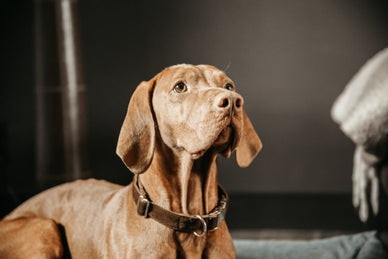
Breed in the spotlight: The Vizsla
The Hungarian Standing Dog, better known as the Vizsla. These Hungarian hunting dogs were initially used as 'pointers'. 'Pointers, what's that all about?" I can hear you thinking. Well, these are dogs that walk the land in search of game such as pheasants or partridges. When they have found a bird, the dog tightens up so that the bird doesn't dare move. This gives the hunter a good chance to shoot the bird. Meanwhile, it is more common for the Vizsla to be used as a pet for your family rather than in hunting.
There are two types of Vizslas, the short-haired and the wire-haired Vizsla. It is generally said that the wirehaired Vizsla is a little quieter than the shorthaired Vizsla.
CHARACTERISTICS:
Origin: Hungary
Life expectancy: 12 to 15 years
Character: energetic, affectionate, friendly and sporty
Weight: Bitch: 18-25 kg, male: 20-29 kg,
Height: bitch: 54-60 cm, male: 58-64 cm
Colors: wheat yellow to light brown
Did you already know these 5 fun facts about Vizslas?
The velcro dog
The Vizsla sticks so hard to its owners that you can almost compare them to velcro. The fact that these dogs are so affectionate is because they were once bred to work with the hunter. So they are only too happy to rely on human attention. Train your Vizsla early enough to be alone. This way you can avoid the development of separation anxiety.
Smart dog but oh so curious
Smart, they are. Learning commands and tricks is done in 1, 2, 3 but still they are very easily distracted. Always looking for a new adventure.
Snow? Get that winter coat out of the closet quickly
Unlike many other breeds such as Labradors and Golden Retrievers, Vizsla's have no undercoat. So they catch the cold faster than their companions. So, duffel them well during the winter.
Zzzzoef! There goes your Vizsla
Vizslas are extremely fast. They are among the top 10 fastest dog breeds in the world with a top speed of 40 km/h.
Almost no Vizsla' left because of the World Wars
During WW1 and WW2 the Vizsla breed was virtually exterminated. Fortunately, there were still some Vizsla's smuggled into Hungary so the breed still had a chance to not disappear from the face of the earth. Fortunately!
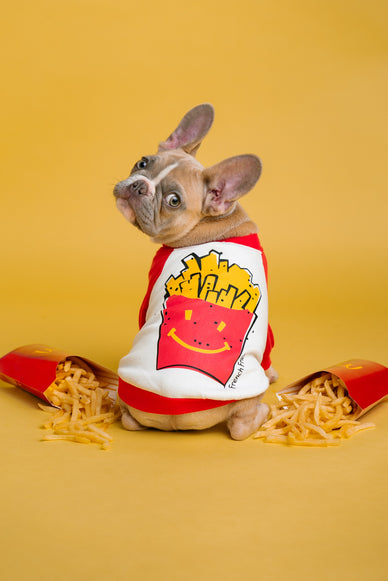
Help, my dog is begging at the table!
Do you have a begging or scrounging four-legged friend running around the house? If so, it can be quite annoying. Dogs are of course by their instinct quite fixated on food. But the typical begging behavior they exhibit is mainly learned by the owners themselves.
And this we understand from time to time. If your dog with his huge puppy eyes stares at you, you can sometimes hard to stop you from him something good to slide. Unfortunately, this encourages the annoying begging behavior. This can be disastrous for both the owner and the dog for several reasons.
Dogs are smart animals and when dogs beg, it is because we have taught them to and your dog knows how to manipulate you to get what they want. Do you find it also pitiful that you can eat as good as every day something new whereas your dog gets every day the same food or do you also want show your love to your dog by letting him feast along of your meal? It does happen often and in several families but still, this is absolutely not the best way to act. Let us explain why!
Atmosphere and friendliness: 0/10
Dogs do not make the same association with food as humans do. For us, food is a social event, it is something cozy to share with your family or friends. It is a moment of relaxation and enjoyment. Unlike dogs, for them food is a means of survival. As soon as they smell food, they start making an effort to get it. In a life-threatening situation it may be that begging is pure necessity but in modern home situations this is absolutely unnecessary, our dogs get enough food and therefore do not need to beg.
Dogs do not link begging (or eating from the table) to love from their owners. You rather show them love by giving them clarity, the correct food, play with them, ... But rewarding by giving food from the table does not belong here.
So it's time to unlearn it! You can do this with the following tips:
#1: Consistency is a priority
Even though it is not easy, when unlearning begging you must be very consistent. No more giving your dog food if he begs, not even a very small piece or on a special occasion. If you want to reward him with something sweet, grab a treat or a chew and give it to your dog at a time of your choosing.
#2: Keep your table manners and your dog separate.
Try to keep the "eating moment" and your dog separate. It often happens that the dog lies under the table while the family is eating but this is better not done. A dog that begs can cause restlessness at the table as they often try to get a piece of the food. It must therefore be made clear to the dog that he is not part of the eating moment. Send your dog, possibly with something tasty such as a chew, to his basket. This will make it clear to him that when the owners eat, he must leave them alone.
Tip: Do you have a new puppy? Then be sure to teach them this from the beginning. Eating time for the owners? Dog in his basket!
#3: Ignore bad behavior
Has your dog been used to begging for some time? Then it will make it a lot harder for you to unlearn this. It is possible that they ask for attention, squeak, bark to get your attention to get that one chunk out of your plate. Do not punish him for this, do not get angry or raise your voice but ignore him for a while. Because by giving him attention in any way while begging, you are rewarding him. So ignore him every time he shows begging behavior or send him to his basket and then say "good" or "good man". In the beginning you will have to repeat this countless times, but patience is a beautiful virtue. Over time, your dog will understand that begging is of no avail and will stop doing so.
It seems that begging is very difficult to get rid of but in practice this is not so bad. The main thing is to remain consistent, with patience you will come very far. You will do yourself and your dog a great pleasure with it. Your dog healthy and happy and you can enjoy your meal in peace again. Hang in there and good luck!
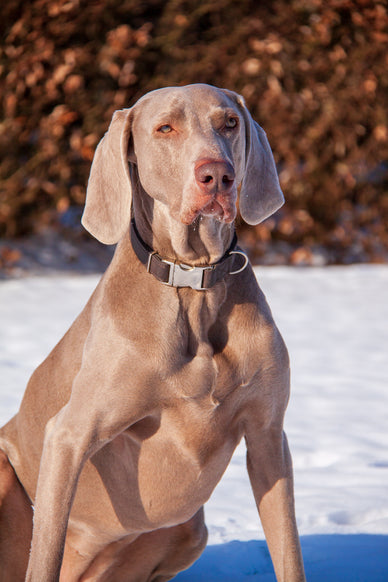
Breed in the spotlight: The Weimaraner
The Weimaraner or the Weimaranian Standing Dog originated in Germany and was originally bred as a hunting dog. This is because they also belong to the club of the fastest dog breeds in the world. The Weimaraner is a large, athletically built dog that is inexhaustible. Owners of this breed should learn how to calm this breed and control their behavior. Curious about some interesting facts about the Weimaraner?
CHARACTERISTICS:
Origin: Germany
Life expectancy: 11 to 14 years
Character: Stubborn, Reticent, Energetic, Intelligent
Weight: Bitch: 25-32 kg, dog: 32-36 kg
Height: bitch: 58-64 cm, male: 64-69 cm
Colors: Mouse gray, silver, silver gray
Real water rats
Almost all Weimaraners love water and are great swimmers. This is due to the flippers between their toes, which allow them to easily paddle through the water (just like Retriever breeds like the Labrador and the Golden Retriever), and it also makes them very suitable for hunting in water.
Nickname: the grey ghost
Most breeds have a nickname and this is true for this breed as well. They are also sometimes called the grey ghost or the gray ghost. The name is fairly obvious, because of their gray and smooth coat but it is also because they can run so fast that sometimes you can only see their gray shadow.
One of the fastest breeds in the world
They are among the fastest officially recognized dog breeds in the world, with only a few dog breeds physically capable of surpassing them. A Weimaraner can reach a top speed of as much as 55 mph while hunting, so don't challenge them to a running race.
This is an important fact for Weimaraner owners, as such an avid runner needs space to run around. Try to find a large dog park or field where your friend can run, or start practicing a sport together like jogging.
Real cuddly bears
It's incredible how attached Weimaraners are to their owners. They want to be with you constantly and will also follow you everywhere, even into the toilet. So don't be surprised if your Weim clings to your leg and won't let go. But they do this out of love for their owner. So you get an enormously loyal friend, who would do anything for you, and who will be there for you when you need him. Moreover, they are insanely cute, so who can say no to that?
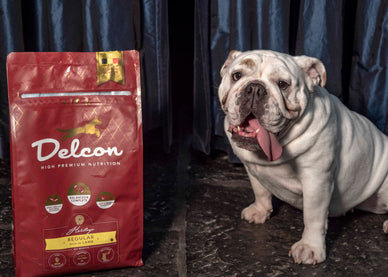
Breed in the spotlight: The English Bulldog
The English Bulldog: friendly, courageous and loves attention. This struishly built, short-legged and well-muscled powerhouse may have a wrinkled and "sourpuss" face, yet they symbolize courage and tenacity. This loyal four-legged companion adapts tremendously well within a family, is good with children and suitable for families with a smaller yard or even an apartment.
CHARACTERISTICS:
Origin: United Kingdom
Life expectancy: 8 to 10 years
Character: docile, friendly, stubborn and social
Weight: Bitch: 18-23 kg, dog: 23-27 kg
Height: bitch: 31-40 cm, male: 31-40 cm
Colors: White, Light Brown, Piebald, Fawn & White, Brindle & White, Red Brindle, Red, Red & White
The Bulldog in summary
The Bulldog can hardly be compared to any other breed. The look with their loose skin, wrinkles across their face, their compressed nose, small ears and drooping jaws makes them stand out very well. In addition to their expressive appearance, Bulldogs have some fun facts! Curious?
Stubborn
English Bulldogs are extremely friendly and gentle little dogs. They are cheerful, like to be with their family and they do not often say no to a hug. An occasional game can charm them but let them do something they do not want to do? That is another matter. Thanks to their stubborn and headstrong character, they do not easily do anything they do not feel like doing.
Fighting with bulls
The name says it all but Bulldogs used to fight with bulls. Biting bulls was a bloody sport that was common in the UK around 1200. The idea was that the Bulldog had to keep himself as low as possible so he could bite the bull in the nose. Fortunately, this bloody sport was completely banned in 1835.
Redundant Bulldog
After the ban on 'bull biting', the Bulldog became 'superfluous' so to speak as they were bred entirely for sport. Their days seemed numbered, luckily there were fanciers who still saw enough potential in the breed. They were bred again but this time to be more gentle. Since then, the dog was used as a loyal four-legged friend in the home.
Do not leave them alone with water
Their build, large head and short legs make it very difficult if not impossible for a Bulldog to manage in the water. Although some like to swim, it's still best to keep an eye on them!
Mascot
The Bulldog was often used as a mascot, just like the Soldiers of the United States. They were often called 'dog faces' or 'dog face soldiers'. But in the 3rd Infantry Division, they took the nicknames in a very different way. The Bulldog was officially approved as a mascot. In 1965, Walt Disney was even commissioned to draw out their mascot, thus Rocky the Marne Bulldog was born.
Health issues
Because the Bulldog is bred in a special way, there are often health problems. Therefore, there are now many variants of the English Bulldog, such as the Olde English Bulldog. This is a healthier and more active variant of the original Bulldog. It stands taller and straighter on its legs and has a less short nose which allows it to breathe easier.
Op zoek naar de ideale hondenvoeding voor je Bulldog? Die kan je hier terugvinden!
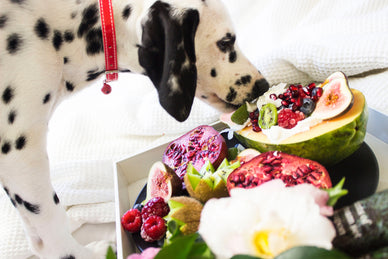
10 things your dog should not eat
Most dogs love to eat, and will eat anything that crosses their path. Although they do their utmost to fish something out of your plate, you better stop them! Not everything that is good for us is automatically good for your four-legged friend... That is why we would like to list 10 things that you should definitely not give your dog!
1. Chocolate
You probably already knew about this one. Chocolate is a real treat for us, but not for your dog. Although it may taste good to them, it does not always lead to happiness for your dog. Eating chocolate can cause vomiting, muscle tremors, cardiac arrhythmia, epileptic seizures and in severe cases can even lead to death. Not recommended!
2. Grapes & raisins
For both dogs and cats, it is not a good idea to serve them grapes or raisins. Even in small amounts, these can cause kidney failure.
3. Dairy Products
Did you know that most dogs are lactose intolerant? You can notice this quickly, after eating dairy products they may have thin stools or even diarrhea.
4. Onion
Onion in large quantities also does not do much good for your dog's body. They provide a large breakdown of red blood cells, resulting in anemia.
PS. Garlic, leek and chives have the same effect!
5. Avocado
Avocado is omnipresent the last few years, enormously popular with the people but again no spit for your dog's mouth! The substance "persin" that is well represented in an avocado, toxic not only for your dog but for virtually all animals. It causes subcutaneous water retention and heart failure with a risk of death. So better not share your avocado!
6. Nuts
The high fat content of nuts can cause stomach problems in your dog. Some nuts are also an absolute no-go - highly toxic - for your dog such as pecan nuts, macadamia nuts, almonds and walnuts!
7. Raw potatoes
Just like avocados, raw potatoes contain a certain substance that dogs can't tolerate: solanine. Eating solanine can lead to gastroenteritis, apathy and in severe cases can even lead to coma.
8. Raw fish
Better keep your sushi to yourself after all! Raw fish can give your dog neurological symptoms!
9. Chicken or turkey bones
Gnawing on a bone, that must be one of the favorite activities of every dog! Yet you better think twice before giving such a bone. Bones of poultry are actually not a good idea at all. They are too small so they can choke, and they can splinter or have sharp edges that can cause damage to the stomach and intestinal walls.
10. Brussels sprouts
Your children are not fans of them but neither is your dog! Because of the harmful substance 'isothiocynate' they can develop stomach problems which can also cause some more 'gas problems'. So don't eat those Brussels sprouts. Your kids, your dog and your nose will thank you!
This list could go on and on. As you can see, your dog is not made to eat with his owners. Keep it for them rather on their tasty kibble and reward them every now and then with a delicious treat or chew!
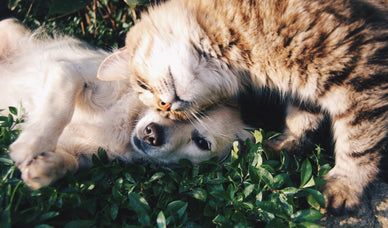
How do you introduce your dog and cat to each other?
The myth that dogs & cats are each other's natural enemies and that their typical body language is unintelligible to each other is in between already outdated. Well socialized dogs and cats can live in perfect harmony with each other. Better yet, some even become inseparable friends! Yet you better give them a hand to make the acquaintance as smooth as possible.
Would you also like to bring a new four-legged friend into your home with your dog or cat? Then read our tips for a responsible introduction between your 2 new friends.
Preparation
Do you already have a dog at home? First take him for a long walk and let him chase his toys. This way he will lose most of his energy and his hunting instincts will be at a lower level.
Do you already have a cat? Make sure they are relaxed and in a familiar space. Don't give them any unnecessary stimuli beforehand. It is best to introduce your new pet at home because new environments can cause your cat a lot of stress. It is extremely important that both dog and cat feel completely at ease!
Note: Do not let the dog immediately at the cat box, this is private territory for your cat and they could be surly if the dog comes too close to their 'palace'.
Sniffing party
There will be a lot of new smells for your four-legged friends! Before you introduce them to each other, let them sniff you first. Through you, they can sniff each other's scent and this is kind of their first introduction.
Time to bring the animals into the house! But first place them separately in each a different room where they cannot see each other yet but can explore the space. Is this a success? Then switch them from one room to another. This way they can sniff out each other's scent again.
Tip: do not forget to reward your animals with treats. This way they associate the new smell with something positive!
The introduction
The moment has come, time for the introduction! Put your cat in a familiar basket or travel bag in a higher place. Keep your dog on a leash and put them at a distance from each other. This way they can have a good look at each other and calm down if they get a bit too enthusiastic. Is this going well? Then give them another reward!
Time for the next step. Let the leash of your dog a little looser and give your cat the opportunity to go where she wants. Make sure there is always an escape route for your cat to a higher place where it can oversee its surroundings. In any case, do not force your animals to greet each other. They set their own pace. Keep a friendly and sweet tone in your voice when you talk to them, that way it is an extra incentive to be friendly to each other.
Body language says it all
The body language of an animal speaks volumes. Does your cat lay its ears flat back and swish its tail back and forth? Then your cat is indicating that it is irritated. Does your dog keep quiet and fix his eyes on the cat? Then he is ready for the 'hunt'. Does he rather frequently lick his lips and yawn? Then he is stressed and feels uncomfortable.
Is your animal showing signs of irritation or discomfort? Have them focus on something else like a treat or take them to another room and try the introduction again at a later time.
Tip: Each time, make sure your own body language is relaxed as well. Animals immediately pick up on the slightest feeling of stress and often take over very quickly.
Patience is key
Introducing your cat and dog is not something you can do in one day. Start the introduction with a few minutes every day and do this a little longer each day. Is everything going calmly and quietly? Then it's time to release both animals and let them get acquainted on their own. There are several scenarios. Some become best friends immediately, for others it takes weeks or even months and for some the spark never comes. Give them time and only leave them together under supervision. If after a few weeks they still do not manage to get along in a calm manner, you can seek help from an animal behaviorist.
Putting it al together
Don't put them together immediately but first let them get used to each other's scent
Reward calm and good behavior
Watch their and your own body language
Prevent stress factors
Do not force your animals to do anything
Good luck!

An extra dog in the house, now what?
The more the merrier. A slogan that sounds quite familiar to you. This can apply to both humans and dogs. A new playmate at first seems like nothing but roses and moons, but the reality is that it is the other way around. But with good preparation, you are already one step ahead of that negative reality!
TIP: NEVER take a second dog if you are already short of time for your first dog. It may seem like the ideal solution for both dogs to be able to entertain each other during the hours when they are alone at home. Yet nothing could be further from the truth, this is rather a recipe for misery. Your newest dog will have difficulties in training, especially when it comes to listening to his owner and the two dogs will be more fond of each other than their owner. So think before you start!
Does your dog agree to this?
A second (or maybe even third, fourth or fifth) dog in the house, your current dog may like this very much or nothing at all. Not every dog is eager for a new four-legged friend in the house. Some dogs have a stronger "pack feeling" than others and you should always respect this.
Risk
Suddenly a new puppy in the house can pose a risk. In the eyes of your current dog, there is suddenly an intruder in the house with whom he has to share everything for the rest of his days. Although this is not always the case, some matches are better than others. It is often recommended to put a male and a female together, which does not alter the fact that both 2 males and 2 females can get along perfectly. The best way to find the ideal match is to see if their energies match.
First impression
Have the first encounter in a neutral place with both dogs on a leash. Take a walk with the dogs together and always reward good behavior, so you create a group feeling for them between the two. After the walk, go into your house with both dogs.
first weeks
The first weeks are always the hardest, everyone is trying to find their way in the new home situation and this can sometimes cause some fireworks. It is best to take some measures to avoid troubles. Like giving each their own toys or taking them away for the initial period. If you feel tension between the two dogs, separate them for a while. Also give each dog its own sleeping place with a basket and its own food bowl.
Body language
Dogs need structure, especially if they live with several people. Times when they are being chased (such as the moment just before they eat, or for a walk, etc.) can sometimes be the perfect excuse to set both dogs on fire at each other. So always avoid such a moment by keeping a close eye on their body language. Do you see one of the dogs getting agitated? Send your dogs back to their place until things calm down.
Double trouble
If you take a second dog (or maybe a third, fourth or fifth dog yourself), take the consequences into account. Multiple dogs in the house also means twice as much dog hair in the house, twice as much dog supplies, double vet costs, etc. A dog that comes into your life usually stays there for 10 to 15 years. Keep in mind whether your dog fits into your future plans. Adding a dog costs time and money but brings you back so much more. An extra dog immediately provides that extra portion of dog love!
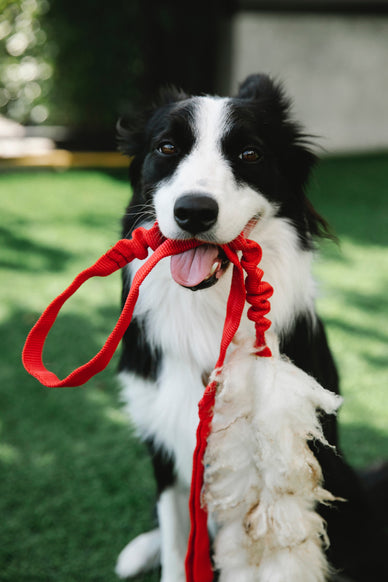
Teach your dog to walk on a loose leash
Are you also tired of your dog pulling on the leash? Then the following tips are the perfect read for you! We will help you teach your dog to walk on a loose leash. With the help of our tips, you will have the job done in no time. A nice and relaxed walk with your four-legged friend is now also your reality!
Why does my dog pull on the leash?
That your dog pulls on the leash is not without reason. It is important to realize for what reason your dog pulls so much on the walk.
There are several reasons but we can categorize them into 4 main ones:
Too enthusiastic
Your dog is sitting with some pent up energy. This pent up energy could be because your dog didn't have an outlet or he never learned how to deal with his energy properly. Because of that pent up energy you get an overexcited dog, where you don't stand a chance if he commands something.
Tip: the solution to this? Play with your dog for 15 minutes before you go for a walk.
Your dog knows it is working
This is actually one of the most common reasons... Your dog simply knows that if he pulls on his leash, he can maintain his own walking pace and that this way he will reach the place he wants to go faster.
As a reaction to an emotion
Your dog has a reaction to the environment - this can be both positive and negative. For example, they pass a place where they have once been frightened very hard, then they prefer to pass by that place as quickly as possible to get away. Or they see another dog, and pull towards it to play. Notice how your dog loses his focus in such situations? Then distract them with a treat. That way you, the owner, have their full attention and you can pass by that one specific spot.
Fright or stress
If you come into a new environment, then there is a chance that your dog experiences stress and pulls to find a safe place as quickly as possible.
Walking on the loose leash
The purpose of walking on a loose leash is that your dog maintains the same pace as you. Walking this way is the most pleasant for both you and your dog since there is no tension on his collar.
There are no written rules concerning where exactly your dog must walk, some people have gladly that their dog walks beside their side whereas others have no preference at all in this. There is no right or wrong in this case.
But let us nevertheless clear up a persistent misunderstanding. If your dog walks in front of you, this does not mean that your dog feels 'above you'. Because did you know that in their packs, it is perfectly normal for the leader to walk all the way behind? This way they have an easy overview of the pack. So don't worry if your dog walks ahead of you, but of course the leash must remain relaxed at all times.
How do you obtain that loose leash?
The main reason why your dog pulls on the leash is because they have lost contact with their owner. Therefore, practice mainly in paying attention to each other and preferably doing that yourself without a leash!
Go to a safe and enclosed field and lure your dog with a treat and an enthusiastic voice.
Tip: never give a tug on the leash when your dog pulls. Many owners have this as a reaction but it does not work! In fact... it makes the pulling even worse. Keep your leash relaxed at all times. Does your dog still pull on the leash? Stand still and only continue when he releases the tension.
Step-by-step plan for walking without pulling on the leash:
Find a safe, enclosed field where there are as few distractions as possible and make sure you are provided with your dog's favorite snacks (make sure you have enough with you)
Take your dog on a leash, give a start signal (such as 'yes' or 'walk') and begin your walk. Reward your dog when he walks with you (without pulling on the leash of course)
Keep walking in circles or back and forth. Still reward your dog if he continues to follow you.
Is your dog pulling on the leash? Then stop walking immediately. Make sure your dog releases the tension on the leash and then step back on.
If this works in the 'distraction-free environment'. Then go step by step to environments with more distractions walking
Once you can manage to walk without pulling in the new environment, it is time to switch back to more challenging environments.
How long does it take for your dog to walk on a loose leash?
It can take quite a while to teach a dog to do this. Especially for puppies who have yet to discover the world, it can be a real chore.
1 golden rule: Train regularly, be consistent but keep it short!
Training sessions should not last longer than 5 minutes each time (best also 2 to 3 sessions per day). The more you practice, the faster you will see results. Take some time during your walk to train this. Sufficient patience is a good virtue, because an angry or frustrated boss will not help your dog during his training!
Sidenote: You have a faster chance of success in teaching a puppy than a senior dog of 8 years. Which is not to say that it is impossible to teach an older dog to pull on a leash. The message remains again that you need a lot of patience and practice, you are training to unlearn 8 years of "pulling history" of course!
Harness or leash?
The eternal dilemma. You have advocates of the leash and you have advocates of the harness. But where is the difference?
A collar says it all: a band that only goes around your dog's neck. The advantage of this is that his body is not obstructed while walking. Your dog has thus less chance to get stuck somewhere. The disadvantages of a collar are that there are many vital organs around the neck. If your dog pulls hard on the leash, this can lead to injuries such as damage to the larynx and trachea, headaches and even displaced cervical vertebrae. All the more reason to teach your dog not to pull on the leash of course ;) . The dog harness goes around your dog's chest and thus distributes the pressure your dog feels when he pulls. The disadvantage of the harness is that it can impede your dog's range of motion....
Dogs pull on both types so one or the other does not offer a miraculous solution to stop pulling. So it's best to take what your dog is most comfortable with.
In summary: tips for relaxed walks
Use every possible moment to train your dog
Always make sure that you have enough treats with you during your walks so that you can reward your dog for good behavior
Make sure there are no distractions during your training. In other words, make sure your dog's other needs are met (like peeing, sniffing, playing)
Never punish your dog! Reward good behavior instead. Does your dog not do what you want? Ignore your dog and stand still. Only as soon as he is calm again or does what you ask, go ahead.
Never pull on the leash yourself because this will have the opposite effect!
Good luck!
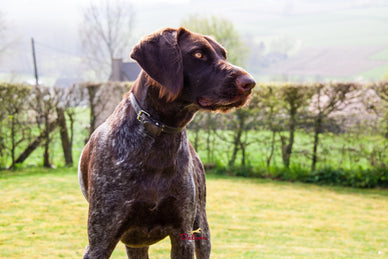
Paying attention during the spring and summer days
FINALLY, the dark days are behind us and spring is here like never before. Warmer temperatures and longer days. Two things that can please everyone, owners and pets alike. Yet those spring and summer days bring with them a few woes here and there. But a forewarned man is worth two. Read our tips on how to combat those ailments here.
#1: Beware of hogweed
Bear claw, what exactly is that! Hear me think to you already. Well, here is a type of plant that everyone has encountered on a walk through a forest. This plant can be recognized by their white inflorescences and large hairy bracts. The plant is often found along the water's edge or on the roadsides. And why exactly should you be wary of this? That's because the sap of a hogweed is poisonous and makes the skin very sensitive. Does your dog in contact with that juice? Then after 1 day he gets all kinds of red, itchy spots on his skin. Those spots can turn into blisters that look like real burns.
How do you deal with this?
Get your dog out of sunlight as soon as possible and rinse the exposed areas with lukewarm water. To be on the safe side, also contact your veterinarian. The healing process takes about 1 to 2 weeks on average.
Tip: If you see this plant growing in a dog walking area or a place where animals frequent, you can report it to the municipality to have the plant removed.
#2: Make sure your dog's vaccinations are up to date
Warm and humid weather is a dream scenario for parasites. Better to prevent than to fight, so make sure your pets are dewormed on time, protected from fleas, etc. It is critical that you always purchase these products from your veterinarian or pet store. Other stores have too little knowledge to give you enough information.
#3: Together with the spring starts the 'tick-season'.
As soon as the temperature rises above 8 degrees, the tick is back there too. From March to October it is important to be extra vigilant for these nasty creatures. Nowadays, there are fortunately pills that you can administer to your dog every 3 months and which protect them against tick bites. Feel free to ask your veterinarian for information on this.
But whether you give medication or not, it is still a good idea to check your dog for ticks after every walk. On average, a tick only establishes itself after 24 hours. So check your dog after every walk, you will save yourself a lot of misery by catching the insects in time.
#4 Beware of blue-green algae
You may not have heard of it but that doesn't make it any less toxic. Blue-green algae are very small organisms that live in fresh and stagnant water and mainly surface during warm temperatures (from May to September). These blue-green algae secrete toxic substances that cause irritation and nausea. You or your dog can become infected by ingesting contaminated water. Dogs often get infected by licking their fur clean after swimming in contaminated water.
You can recognize such blue-green algae by their color, which varies from very light blue to green, turquoise and sometimes even reddish brown and they spread in floating "flakes" in the water. Often there is also a message from the municipality if blue-green algae is present somewhere in the water.
Are you or your dog infected with the blue-green algae? Then there may be symptoms of irritation to the eyes, skin, headache, nausea and fever for 5 days. It is best to contact your veterinarian if you see these symptoms in your dog.
#5: Don't let your dog run after insects
Does your dog or cat dare to chase a wasp already? If so, call them back to you quickly anyway. Because just about every animal is allergic to the chemicals in the sting of insects. This means that if they are stung by an insect, that place immediately begins to swell. If this happens near the face, it can lead to breathing problems (especially if stung in the throat or tongue). If you see swelling coming up, first see if you can see the sting & then go to the vet as soon as possible.#6: Help your dog get rid of his winter coat
Temperatures are rising so our winter coat may go back into the closet. This applies to us but also to our pets. As soon as the days get warmer, your pet will want to get rid of his winter coat as soon as possible. You can help your dogs with that, fortunately. Brush your dog daily, and then go over his coat with a wet cloth. This way you stimulate the 'shedding process' and prevent the dead hairs from sticking together.
#7: Your pet can also suffer from hay fever, unfortunately....
During the period from March to October, many people suffer from hay fever. But this hay fever does not only occur in humans but also in animals. It only manifests itself differently in animals than in humans. Dogs do not sneeze or have a runny nose, they rather get an itch which they scratch. This in turn can lead to coat problems.
How do you recognize hay fever in your pet?
Itching around the face, mainly at the muzzle or ears
Itching on the sides, armpits or back
Recurring ear infection
Irritation to the eyes (swollen and red)
Irritation of the soles of the feet
What can you do about this?
Adjust your dog's diet to one that is going to support his skin and coat. Foods like Delcon Regular Plus - Rich in Fish can help with this. In addition, make sure that his coat stays clean and that no pollen or other dirt is left in his coat.
Also, discuss it with your veterinarian. A skin allergy test can be done to see what your dog is allergic to. That way, your vet can prescribe medication if necessary.
#8: Take the heat into account
Did you know that dogs get really hot at 20°C? So don't go doing active things (like walking, running or cycling) with your dog at such temperatures, because there is a good chance your dog will overheat. Give him enough rest and shade during hot days. This is because a dog that is overheated has a much harder time getting rid of heat than humans. This can even lead to a fatal outcome in dogs.
And it is already shouted from the rooftops but still we find it so important to repeat again: NEVER LEAVE YOUR DOG ALONE IN THE CAR IN WARM TEMPERATURES. The temperature in a car can easily rise to 50 to 60°C in 10 minutes and your dog will not survive that. Even leaving the window ajar or parking your car in the shade won't help!
So, with these tips you can fully enjoy (and be prepared for) the wonderful spring days together with your beloved pets.

New puppy in the house: now what?
Have you been looking forward to the homecoming of your new puppy for weeks (or who knows months or years)? Then the days probably can't move forward fast enough for you. But it is still of great importance to make sure that you are optimally prepared for this big day. The transition from their litter and their mom to a new home on their own takes a lot out of our little four-legged friends.
But don't panic, with these tips you will already make it a lot easier for your pup.
Make it as comfortable as possible
Put your puppy's basket in a cozy and quiet corner. Put a pillow and possibly a cuddly toy in that basket where your pup can nestle against it when they need it. Buy the basket not at the smallest because your puppy will soon get solid growth spurt and then you can equal its first basket in the trash.
Tip: ask the breeder a few days before picking up the pup if you can put a cuddly toy in the litter. That cuddly toy will take over the smell of the litter. Put it in the basket of your pup once it is at home. This will provide some reassurance to your pup.
Make it as comfortable as possible
Put your puppy's basket in a cozy and quiet corner. Put a pillow and possibly a cuddly toy in that basket where your pup can nestle against it when they need it. Buy the basket not at the smallest because your puppy will soon get solid growth spurt and then you can equal its first basket in the trash.
Tip: ask the breeder a few days before picking up the pup if you can put a cuddly toy in the litter. That cuddly toy will take over the smell of the litter. Put it in the basket of your pup once it is at home. This will provide some reassurance to your pup.
If your puppy is now over 7 months old, it is better to switch from puppy chunks to junior chunks. This will provide the perfect transition to switch to adult dog food.
Delcon Junior supports your puppy in building muscle mass in the right way, it also ensures that the constitution and joints take on the final shape in a balanced way.
Ensure good health
Your puppy is very vulnerable in the beginning. Make sure you take the necessary measures to protect your puppy from as many parasites as possible. If you notice that your puppy is not feeling 100%, do not hesitate to contact your vet.
Make your house puppy proof
Puppies are just like babies. Everything that comes their way is interesting and should be checked out up close. Make sure you can provide a safe new home for your dog and keep the following items in the danger zone:
- Fragile items
- Electronic wiring
- Do not leave things lying around that are easy for a puppy to eat (stockings, jewelry, children's toys, etc.)
- Store laundry detergents and other chemicals properly
- Be sure to screen off your pool
- Be careful with poisonous plants such as azaleas, yews, ivy, etc.
Routine
Believe it or not but your dog benefits tremendously from routine in daily life. This routine will make it easier for you to teach them things.
Now what do I mean by such a routine, I hear you already thinking! Well, with this I mean that you give your pup for example 3x a day at the same time and at the same place its food. Or at the same time (and the same place) goes outside for a pee.
Apply these tips and make the homecoming for your pup and for yourself already a lot easier!

Waarom hondenvoer van Delcon?
Waarom je voor Delcon moet kiezen? Dat is een goeie vraag waar we je uitgebreid antwoord op kunnen geven! Bij Delcon Petfood streven we ernaar om een icoon van ware kwaliteit binnen de professionele wereld van premium dierenvoeding te zijn, zowel voor je hond als voor je kat. Onze voeding is met veel zorg geformuleerd. Ze is enkel opgebouwd uit de meest verfijnde ingrediënten. Zo bekomen wij de meest gezonde voeding waarop jij trots mag zijn dat je ze aan je geliefde viervoeter kan geven.
We houden zelf enorm van onze viervoeters en willen daarom enkel het beste voor hen. Daarom is onze voeding rijk aan vlees omdat dierlijke eiwitten zo belangrijk zijn voor je huisdier. De prebiotica in Delcon zorgen voor de ondersteuning van een goede darmflora en bijgevolg een optimale vertering. Daarnaast staat Delcon erom gekend een heel hoge acceptatie te hebben met een goede vertering en beperkte ontlasting als gevolg. Natuurlijke antioxidanten zorgen ervoor dat de kwaliteit van de ingrediënten in Delcon behouden blijft. Delcon bevat enkel de hoogst kwalitatieve ingrediënten waaronder ook ‘human grade’ zalmolie die de algemene gezondheidstoestand van je hond en kat ondersteunt.
Waar kan in de samenstelling van de voeding terugvinden?
Je kan de samenstelling van elke soort hondenvoer of kattenvoer terugvinden op onze website en webshop alsook op de achterkant van je zak voeding. Indien je extra vragen hebt over de samenstelling van de voeding, stuur dan gerust een mailtje naar info@delcon.be
Hebben jullie voeding die geschikt is voor puppies en jonge honden?
Jazeker! Delcon puppy is geschikt voor alle soorten pups. Met Delcon Puppy kies je voor complete voeding die van bij de start een stabiele groei van uw hond ondersteunt. Door het hoge percentage in eiwitten en vetten bevat Delcon Puppy alle voedingsstoffen die uw nieuwe huisgenoot nodig heeft om de eerste levensmaanden op een gezonde en gebalanceerde manier de groeispurt door te komen en het immuniteitssysteem op te bouwen.
Ook de jonge hondjes tussen +/- 6 maand en 1,5 jaar vergeten we niet! Delcon Junior is de perfecte voeding voor de overgang van de puppy-voeding naar een adult-variëteit. In deze levensfase is het van groot belang de spiermassa op een juiste manier op te bouwen, alsook ervoor te zorgen dat het gestel en gewrichten op een evenwichtige manier de finale vorm verkrijgen. Deze brok bevat alle nodige voedingsstoffen om de groei op een stabiele manier te ondersteunen.
Wanneer moet je overschakelen van Delcon Puppy naar Delcon Junior
Hoelang mag je pup puppy voeding eten?
Voor kleine rassen: 1-12 maand
Voor middelgrote rassen: 1-8 maand
Voor grote rassen: 1-6 maand
Opgelet! De kleine rassen mogen na 12 maand onmiddellijk overschakelen op volwassen voeding.
Is je hond (van middelgroot of groot ras) rond 6 à 8 maand, afhankelijk van de grootte van het ras, dan wordt het tijd om over te schakelen naar Delcon Junior.
Waar kan je de voedingstabellen terugvinden?
Die kan je terugvinden op de website/shop of op de achterkant van je zak voeding.
Hoeveel en hoe vaak eet een puppy?
Voor puppies:
In de linkerkolom vind je het gewicht terug die je pup heeft als hij volwassen is. Bovenaan kijk je hoe oud je pup is op dit moment, in de rij eronder zie je hoeveel maaltijden je pup mag eten per dag. Tot hun 6 maand, verdeel je de hoeveelheid over 3 maaltijden. Later mag je overschakelen naar 2 maaltijden. Bij recommended quantity zie je hoeveel gram je pup per DAG mag eten. Deze hoeveelheid verdeel je dan over het aantal maaltijden je pup mag eten.
Even schetsen adhv een voorbeeld: Je hebt een boxer pup van 5 maand oud. Een boxer weegt als volwassen hond ongeveer 25kg, dus links kijk je naar de 25kg. Nu is de pup 5 maand oud, dus kijk je bovenaan tussen 4-6maand. Daar zie je dat je pup 3x per dag mag eten. Dus je pup mag 380gr per dag eten en dit verdeel je over drie maaltijden.
Hoeveel en hoe vaak eet een hond?
Voor volwassen honden:
In de linkerkolom zie je het gewicht van je hond. Bovenaan zie je de activiteitsgraad van je hond. Kijk bij het gewicht van je hond en zijn activiteitsgraad, hoeveel gram je hond per dag mag eten. Dit gewicht mag je dan verdelen over 2 maaltijden.
Even schetsen adhv een voorbeeld: Je hebt een Boxer van 2 jaar oud, weegt 22kg en is enorm actief. Dan zie je dat je hond 330gr per dag mag eten die je mag verdelen over twee maaltijden.
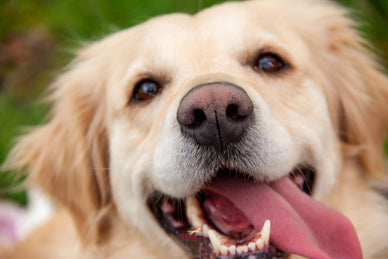
Denkspelletjes voor je hond, de optimale tijdsbesteding
Dat een hond veel beter kan ruiken dan een mens, wist je waarschijnlijk al. Dat een hond zijn neus achternagaat is dus maar meer dan normaal. Je hond vindt het fijn om met zijn neus aan het werk gezet te worden! Breinwerk voor je hond dmv denkspelletjes en snuffelspelletjes stimuleren je hond z’n hersenen, geeft ze een voldaan gevoel én schept er bovenop nog eens een betere band met z’n baasje. Zeker de moeite waard om eens uit te proberen, nietwaar?
Hoe begin je hieraan?
Je hoeft niet per se spelletjes kopen in de winkel. Je kan gerust met de huishoudspullen die je thuis hebt liggen, een fantastisch spel creëren voor je hond! Lege flessen, kartonnen dozen, oude stukken stof, siliconen bakvorm, … je noemt het maar op en je kan er wel iets van maken waar je je hond kan mee entertainen. Zo goed als alles is geschikt om een lekker hondensnoepje in of onder te verbergen (zolang het materiaal natuurlijk veilig is voor je hond).
Voorbeeld: Laat je creativiteit om los en maak zelf een snuffelmat van oude lapjes stof die je hebt liggen. Verstop er een aantal hondensnoepjes in en laat je hond er maar op los snuffelen. Of vul een kartonnen doos met lege wc-rolletjes en verspreidt er z’n lekkere hondenbrokjes in.
Het doel van hondenspelletjes
Hersenwerk voor je hond biedt tal van voordelen. Het helpt het concentratievermogen van je hond, haalt zijn energiepeil naar omlaag, maar het voordeel dat er torenhoog bovenuit springt, is toch wel het feit dat het je hond zijn brein stimuleert. In plaats van hun spieren in het werk te zetten (in bv. een trektouw spelletje), zet je nu hun neus in het werk om bepaalde zaken op te speuren. Wat fantastisch is voor je hondje, het geeft hun een voldaan gevoel. Schakel regelmatig hersenspelletjes in de wekelijkse routine van je hond, het zal je hond zijn denkvermogen scherp houden.
Connectie
Naast het feit dat het een stimulans is voor het brein van je hond, helpt het ook je hond zijn energie kwijt te spelen. Maar begrijp ons niet verkeerd, het is natuurlijk een ander soort vermoeidheid dan na een grote wandeling. Honden hebben zowel fysieke als mentale uitdagingen nodig! Binnen de fysieke en mentale uitdaging staat de connectie met het baasje ook centraal. Door samen te werken en te spelen, ga je je hond van dichterbij leren kennen en zien hoe hij omgaat met het oplossen van ‘problemen’ of puzzels. Op die manier kan je snel verder werken op zaken die je hond fijn vindt om te doen.
Puzzelen voor iedereen
Hersenwerk is voor elk soort hond weggelegd, als het goed wordt getoond aan de hond. Het spel moet aangepast zijn aan de behoeften van je hond. Voederen vanuit een KONG waarbij de hond moet likken en kauwen werkt rustgevend. Terwijl voeding in een voederbal geven eerder voor meer energie zorgt. Heb je een hond die wat meer beweging kan gebruiken? Dan is een voederbal eerder de juist keuze voor jullie. Moet je hond zich voor eender welke reden (zoals een operatie gehad) zich eerder rustig houden? Dan zijn denkspelletjes ook de ideale oplossing om hen actief en bezig te houden.
Tijd om een hersenspelletje in huis te halen!
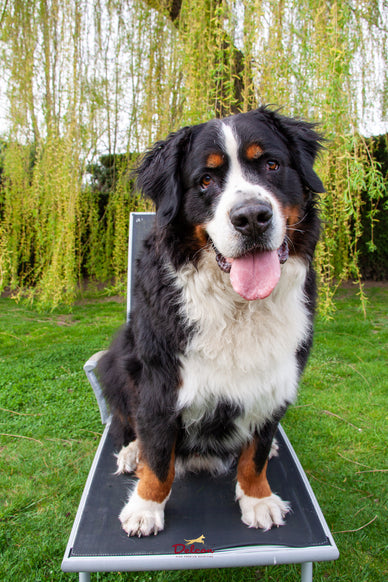
Help, het is rui seizoen!
Net je hele huis gestofzuigd en je ziet na 5 minuten alweer overal plukje haar liggen? Je bent niet alleen! Als temperaturen aanzienlijk stijgen of dalen, wordt het verharen van je dier een pak erger. Met de Herfst die net gearriveerd is, is de ‘ruiperiode’ opnieuw volop aangebroken. Maar hoe werkt een rui nu helemaal? En wat kan je eraan doen om het je dier zo comfortabel mogelijk te maken?
Waarom verharen ze?
Nu het weer wat kouder wordt, is het tijd om hun zomerplunje terug de kast in te hangen en hun winterjas weer aan te trekken, bij wijze van spreken natuurlijk! Voor katten geldt net hetzelfde. Met als gevolg: overal in huis haren… Maar hoe komt dit?
De vacht van je dier helpt hen bij het reguleren van temperaturen. Ze zorgen ervoor dat het hen warm of koel houdt. Tweemaal per jaar, bij de seizoen wissels, verliezen zowel kat als hond een pak haar. Zo’n periode van rui kan 3 à 4 weken duren en zorgt daarbij ook voor de nodige irritatie bij het dier én het baasje. Om deze irritatie op een laag pitje te houden, is het belangrijk te weten wat te doen.
Elke vacht is anders
Ken de vacht van je dier, want bij elk ras verschilt de vacht. Daarom heeft elk ras een andere verzorging nodig. Sommige hondenrassen verharen het hele jaar door maar in heel lichte mate en niet tweemaal per jaar in een piek zoals de Labradoodle, deze soort honden hebben een knipvacht. Het is noodzakelijk van hen vaak te borstelen om de losse haren uit hun vacht te halen. Terwijl je ook honden hebt met een plukvacht, ook zij verharen het hele jaar door maar die losse haren blijven hangen in de vacht. 2 maal per jaar worden die dode haren eruit ‘geplukt’ zodat de nieuwe ondervacht ademruimte krijgt. Het is van groot belang dat je nagaat welke vachtverzorging jouw hond nodig heeft. Stel dat je een hond met plukvacht gaat bijknippen, wordt hun vacht grauw en gaan de dode haren jeuken. Of borstel je de vacht van een kniphond te weinig? Dan klit de vacht samen en hoopt het vuil zich op.
Wist je dat: honden met een knipvacht minder verharen, mààr ze moeten wij op tijd en stond geknipt worden.
Hoe onderhoud je best de vacht tijdens de ruiperiode?
Jaren terug in tijd verzorgden honden hun eigen vacht, zonder enig probleem. Het verharen verloopt natuurlijk onder invloed van temperatuur en honden verwijderen zelf voor dat de losse haren dmv likken, in plassen te ronden of zich over het gras te schuren. Maar doordat honden tegenwoordig vaker binnen leven, kan hun balans verstoord worden. Daarom is het van belang dat we onze honden een handje helpen door regelmatig de losse haren weg te borstelen. Zeker tijdens de rui periode, help je je dieren hier enorm mee.
Let op: bij kortharige honden kan te veel borstelen de huid beschadigen. Hou hier rekening mee.
Keuze hondenborstel
Zorg ervoor dat je zeker de juiste hondenborstel koopt. Voor kortharige honden is een rubberen borstel of een borstel van haar meer dan voldoende terwijl voor langharige honden eerder een kam of slickerborstel nodig is om hun klittende vacht los te krijgen.
Voorbeeld van een slickerborstel:
Hoe borstelen
Druk zeker niet te hard tijdens het borstelen om irritatie over de huid te voorkomen. Om ook klitten te voorkomen, is het goed om volgende plekken wat extra aandacht te schenken tijdens het borstelen:
Bij de snuit
In de oksels
Rond de oren
Rond de voetzolen
Onder de staart
Helpt wassen?
Het antwoord: Ja maar voornamelijk voor langharige honden! Soms kan je hond wassen ook voor een verademing zorgen bij hen. Door het stromende water en shampoo week je automatisch de dode haren los. Blaas nadien je hond met koele licht droog om zo extra klitten te voorkomen. Doe dit 1 à 2 keer in de rui periode.
Voor kortharige honden is dit minder van belang. Te veel wassen kan de huid onder de vacht beschadigen.
Extra hulp nodig?
Heeft je hond vaker last van extreem vacht verlies of staat de vacht dof en levenloos? Dan kan je, naast een goede verzorging, ook de voeding aanpassen van je hond. Delcon Regular Plus – Rich in Fish is de perfecte voeding voor honden die extra zorg nodig hebben voor hun vacht dankzij de toevoeding van extra zalmolie. Kom hier alles te weten over deze voeding
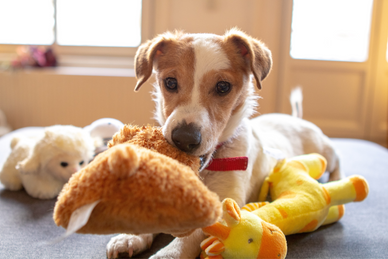
5 leuke spelletjes om binnen te spelen met je hond
Een regenachtige dag is niet leuk voor jou en al zeker niet voor je hond. Jij mist het om een frisse neus te halen, je hond is verknocht aan z’n dagelijkse fysieke uitdaging. Laat de neerslag de pret niet bederven. Dat je ook binnen fijn met je hond kan spelen, bewijzen de vijf spelletjes die je in dit artikel ontdekt. Is het geen weer om je hond door te jagen? Speel dan binnen!
1. Zoek het snoepje
“Zoek het snoepje” is een fantastisch spelletje dat de hersenen en de neus van je hond aan het werk zet. Met al die verstopplaatsen in huis is het een ideale activiteit om binnen met je hond te doen.
Moeilijkheid
Benodigdheden?
Leertijd
Gemakkelijk
Snoepjes zoals de Delcon Treats en een rustige plek
1 tot 4 weken
---article-upsell-here---
De voorbereiding
Voor je “Zoek het snoepje” begint te spelen, zoek je een rustig plekje in huis. Hou enkele van de favoriete snoepjes van je hond bij de hand. Wees geduldig. De ene hond snapt het spelletje meteen, de andere heeft wat meer tijd nodig. Hoe jonger je hond, hoe makkelijker hij het zal oppikken.
Hoe snel je hond ook leert, hou het leuk voor jullie beide. Zelfs al lukt het niet meteen, weet dat je hond aan het leren is en zijn brein hard aan het werken is.
Aan de slag
Vraag je hond om te zitten en te blijven.
Toon je hond het snoepje en gooi het op de grond.
Geef je hond de toestemming om het snoepje te halen.
Dat doe je door bijvoorbeeld “Zoek!” te zeggen. Herhaal deze stap enkele keren zodat je hond snapt wat de bedoeling is.
Laat je hond terug naar jou komen.
Om het spelletje uitdagender te maken, doe je het volgende:
Gooi het snoepje steeds verder. Het is de bedoeling dat je hond blijft zitten tot je hem vraagt het snoepje te zoeken.
Verstop het snoepje achter, in of onder iets. Gebruik bijvoorbeeld een snuffelmat om je snoepje in te verstoppen.
Heeft je hond het moeilijk om te blijven zitten tot je toestemming geeft het snoepje te halen? Werk dan met een lijntje tot je hond zijn impulsen beter onder controle heeft.
2. Touwtje-trek
Door touwtje-trek te spelen, kan je hond zijn energie meteen kwijt. Speel het bijvoorbeeld als je een langere tijd van huis bent geweest en je hond al die tijd alleen was. Je overactieve hond is na enkele minuten touwtje-trek al heel wat kalmer en dankbaar voor alle aandacht!
Moeilijkheid
Benodigdheden?
Leertijd
Gemakkelijk
Snoepjes zoals de Delcon Treats, een stevig touw
2 tot 7 dagen
De voorbereiding
Kies een speeltje op maat van je hond. Het spreekt voor zich dat een uit de kluiten gewassen Tervuurse Herder een steviger touw vraagt dan een Jack Russel. Je vindt speciale touwen voor honden in een dierenspeciaalzaak of je knutselt zelf een speeltje ineen door enkele lappen stof stevig aan elkaar te knopen.
Maak je hond enthousiast zodat hij zich gemotiveerd voelt om z’n tanden in het speeltje te zetten. Met een snoepje als beloning wordt dit vast en zeker één van z’n favoriete spelletjes.
Aan de slag
Zoek een plekje in huis met voldoende plaats om touwtje-trek te spelen
Hou het touw bij de hand en enkele snoepjes in je broekzak.
Presenteer het touw aan je hond
Hou het touw voor hem. Niet elke hond zal meteen interesse tonen. Doe er zelf enthousiast over, laat het voor zijn neus bengelen of verleid hem met een snoepje.
Moedig je hond aan om te trekken
Verbind er ook een commando aan zoals “Trek!”. Hou het speels zodat je hond snapt dat het een spelletje is.
Wacht op contact
Elke aanraking met het touw of speeltje is een reden voor een beloning. Zo weet je hond dat als hij interesse toont, hij een snoepje krijgt.
Wees consequent en geduldig
Herhaal dit proces enkele keren maar verleg steeds z’n grenzen. Vraag meer interesse van je hond in ruil voor een snoepje. Doe dit tot hij snapt dat hij aan het touw hoort te trekken. Geef hem daarna pas een snoepje in ruil voor 10 seconden touwtje-trek, 20 seconden touwtje-trek, 30 seconden touwtje-trek, … Op termijn heeft hij enkel nog jouw commando “Trek!” nodig om te weten wat je van hem vraagt.
3. Welke hand?
“Welke hand?” is een heel eenvoudig spelletje dat je om het even waar en wanneer kan spelen. Het enige wat je nodig hebt is enkele snoepjes en je handen.
Moeilijkheid
Benodigdheden?
Leertijd
Gemakkelijk
Snoepjes zoals de Delcon Treats
2 tot 7 dagen
De voorbereiding
“Welke hand?” stelt de hersenen en de neus van je hond op de proef. Je vraagt hem niet enkel z’n reukvermogen te gebruiken, je stimuleert ook het denkvermogen van je hond. Dit alles in een heel eenvoudig maar oh zo leuk spelletje. Het enige wat je nodig hebt, zijn je handen en enkele van z’n favoriete snoepjes.
Gebruik in het begin bij voorkeur snoepjes die sterk ruiken, zoals onze snoepjes met zalm, eend of lam. Heeft je hond een favoriete snack? Kies die dan uit. Zo krijg je hem extra gemotiveerd.
Aan de slag
Snoepje in de hand
Vraag de aandacht van je hond en toon hem dat je een snoepje in één van je handen hebt. Sluit beide handen en presenteer ze aan je hond.
Welke hand?
Vraag je hond “Welke hand?” en wacht tot hij een voorkeur toont voor één van je handen. Open vervolgens die hand. Heeft hij het bij het rechte eind? Dan heeft hij het snoepje gewonnen! Was hij verkeerd? Toon dan het snoepje maar geef het niet. Probeer het spelletje opnieuw tot je hond het juist heeft.
Wil je het spelletje uitdagender maken? Verstop je beide handen dan achter je rug en wissel het snoepje tussen je handen. Zo weet je zeker dat je hond enkel op zijn geur rekent en niet op wat hij ziet.
4. Het bekertjes-spelletje
Het bekertjes-spelletje bouwt voort op het “Welke hand?”-spelletje. Het principe is hetzelfde met dat verschil dat je bekertjes gebruikt in plaats van je handen. Vindt jouw hond meteen onder welk potje je het snoepje hebt verborgen?
Moeilijkheid
Benodigdheden?
Leertijd
Gemakkelijk
Snoepjes zoals de Delcon Treats, 3 bekertjes
1 tot 4 weken
De voorbereiding
De enige voorbereiding die dit spelletje vraagt, is drie bekertjes. Kies voor plastic en niet voor glas of papier. Papier is niet stevig genoeg en glas kan breken. Maak een gaatje in de onderkant van elk bekertje zodat je hond het snoepje kan ruiken. Eens je hond het spelletje goed kent, gebruik je bekertjes zonder gaatje.
Aan de slag
Vraag de aandacht van je hond
Verstop een snoepje onder een bekertje
Vraag je hond om het snoepje te vinden
Om dit spelletje moeilijker te maken, voeg je simpelweg extra bekertjes toe.
5. Samen opruimen
Na een speelmomentje met de hond ligt je huis er gegarandeerd rommelig bij. Waarom niet het nuttige aan het aangename koppelen en je hond leren zijn eigen spullen op te ruimen?
Moeilijkheid
Benodigdheden?
Leertijd
Moeilijk
Snoepjes zoals de Delcon Treats, enkele speeltjes en een mand om de speeltjes in op te bergen
2 tot 6 weken
De voorbereiding
Neem er de doos, mand of ton bij waarin je de speeltjes van je hond verzamelt. Slingeren er nog geen speeltjes rond, leg er dan enkele op de grond. Hou ook enkele snoepjes bij de hand om je hond te belonen.
Je hond leren opruimen is niet makkelijk. Zorg ervoor dat je hond al de basis kent zoals “zit” en “blijf”. Lukt het niet na één sessie? Wees geduldig en consequent. Je hond heeft tijd nodig om nieuwe dingen te leren. Geloof ons: hij is het wachten waard!
Leren opruimen stimuleert de hersenen van je hond en laat hem z’n overtollige energie kwijtraken. Eens de speeltijd over is en alles is opgeruimd, is je hond voldaan en klaar voor z’n welverdiende dutje.
Aan de slag
Leer je hond om een speeltje te nemen.
Hiervoor hou je z’n favoriete speeltje voor z’n snoet. Net voor hij het speeltje wil nemen, zeg je “Pak!”.
Leer je hond om het speeltje los te laten.
Nu je hond z’n speeltje vast heeft, verleid je hem met z’n favoriete snoepje met zalm, eend of lam. Van zodra hij voor het snoepje kiest en het speeltje laat vallen, zeg je “Los!”.
Leer je hond z’n speeltje in de mand leggen.
Leg daarvoor enkele speeltjes rond de mand, wijs naar een speeltje en zeg “Pak!”. Van zodra je hond het speeltje vast heeft, begeleid je hem met een snoepje richting de mand. Eens zijn hoofd boven de mand is, zeg je “Los!”. Valt het speeltje in de mand, beloon je je hond met het snoepje.
Leg de speeltjes verder van de mand.
Blijf verder oefenen met de snoepjes maar verminder het aantal keren dat je je hond beloont. Introduceer het oppakken en in de mand laten vallen van de speeltjes geleidelijk aan als “Opruimen!”.
Herhalen, herhalen, herhalen.
Herhaal het opruimen elke dag gedurende minimum twee weken. Merk je dat je hond een stap niet zo goed onder de knie heeft, oefen dan specifiek op dat commando.
Waarom binnenspelen met je hond?
Nu je weet hoe je je hond ook binnenshuis entertaint, laten we even in het brein van je hond duiken en ontdekken waarom spelen zo belangrijk is.
Waarom spelen honden?
Als je hond al in je leven is sinds hij puppy is, zat je op de eerste rij toen hij op het toppunt van z’n speelsheid zat. Puppy’s leren over de wereld rondom hen door te spelen. Ze onderzoeken hun omgeving met hun neus, tong en tanden. Zo leren ze wat aanvaardbaar sociaal gedrag is en wat hun grenzen zijn.
Ook volwassen honden blijven spelen, zowel met hun baasje als met andere honden. Meer nog: honden spelen het liefst in gezelschap. Dat ze speels blijven wil niet zeggen dat ze nooit volwassen worden. Spelen vervult enkele belangrijke functies. Hieronder vind je er vijf.
1. Spelen is gezond
Spelen heeft niet enkel fysieke voordelen, je stimuleert er ook de hersenen van je hond mee. Via een spel raakt je hond z’n opgebouwde energie kwijt. Zelfs een korte sessie van 5 à 10 minuten maakt een wereld van verschil. Ook jij ervaart vast en zeker de voordelen van wat extra beweging in je dagelijkse routine.
Het is ook een ideale manier voor je hond om stress van zich af te schudden. Hij geniet met volle teugen als hij tijd met jou spendeert. Studies verwijzen ook naar de kalmerende effecten van honden op mensen. Mensen met een hond zouden een lagere bloeddruk hebben en minder kans maken op hartziekten. Wat er ook van aan is, een speelkwartiertje met je hond inlassen, heeft voordelen voor je hond en voor jezelf.
2. Een hond kan zich vervelen
Net zoals wij vervelen honden zich soms. Dat gebeurt als ze te weinig uitdaging krijgen. Door te spelen, te wandelen en mentale stimulans, blijven ze geëntertaind en gaan ze kattenkwaad uit de weg.
Een hond die zich verveelt, herken je aan gedrag zoals blaffen zonder reden, je spullen kapot bijten, je storen terwijl je werkt, je bloemperk omwoelen, … Door af en toe een spelletje te introduceren, vermijd je dit. Dat hoeven niet per se fysieke spelletjes te zijn, ook denkspelletjes doen de verveling van je hond verdwijnen.
3. Spelen = leren
Als je hond speelt, staan al z’n zintuigen op actief. Het is daarom ook een van de leukste manieren om je hond te trainen. Geloof het of niet: een spelletje spelen, is je hond iets aanleren. Terwijl je met hem speelt, geef je hem namelijk een taak. Vervult hij die taak, wordt hij beloond. De leukste manier voor een hond om te leren en te blijven leren.
4. Een nog hechtere band
Net zoals speeltijd puppy’s alles over relaties en sociale vaardigheden leert, toon je met spelen aan je hond dat je er voor hem bent. Hij krijgt jouw onverdeelde aandacht en leert je vertrouwen. Hij komt bijvoorbeeld te weten dat als hij het balletje dat jij net hebt weggegooid terugbrengt, jij dat balletje opnieuw zal weggooien. Hij leert dat sommige van jouw acties voorspelbaar zijn. Dat geeft je hond vertrouwen.
5. Je hond wordt meer zelfzeker
Een spelletje doet beroep op het deel van de hersenen van je hond dat instaat voor het nemen van beslissingen en het controleren van impulsen. Honden die vaak spelen, blaken van zelfvertrouwen. Ze kunnen erop vertrouwen dat ze de juiste keuze zullen maken. Zowel in interactie met jou als met soortgenoten.
Veelgestelde vragen over binnen spelen met je hond
Hoe vaak moet ik met mijn hond spelen?
Het is belangrijk om elke dag met je hond te spelen. Dat is belangrijk voor hun mentaal en fysiek welzijn.
Hoe lang moet ik spelen met mijn hond?
In een ideale wereld krijgt een hond elke dag een half uur tot twee uur speeltijd. Dat lijkt enorm veel, zeker als je een fulltime job hebt. Denk daarom na welke momenten je kan omtoveren tot een spel. Bijvoorbeeld etenstijd. Waarom je de brokken van je hond in een kom gieten als je er ook spelletjes zoals “Welke hand?” of “het bekertjes-spelletje” mee kan spelen. Ook je dagelijkse wandeling leuk je eenvoudig op met een van de bovenstaande spelletje.
Moet ik mijn hond de hele dag entertainen?
Honden krijgen graag aandacht. Spendeer dan ook zoveel mogelijk tijd met je hond. Een spelletje introduceren is een perfecte manier om zijn energieniveau te doen dalen en hem mentaal uit te dagen. Zo slaagt hij er beter in om zijn spreekwoordelijke emmertje te legen.
De meeste volwassen honden slapen minstens 12 uur per dag. Hem aanleren om rust te vinden is minstens even belangrijk als voldoende entertainment.
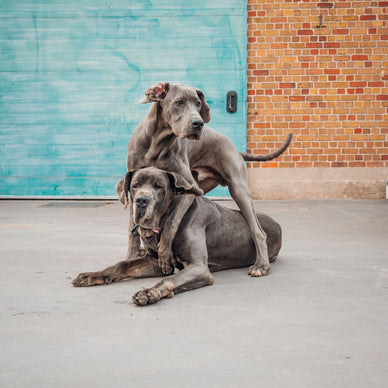
De juiste hondenvoeding per levensfase
Geef je hond voeding die met hem meegroeit.
Waarom voeding aangepast aan de leeftijd ertoe doet.
Als hondenbaasje wil je het beste voor je viervoeter. Daarin speelt voeding een sleutelrol. Net zoals de voedingsbehoeften van mensen veranderen naargelang hun levensfase, heeft ook je hond andere voeding nodig als hij ouder wordt. De juiste voeding op het juiste moment ondersteunt groei, gezondheid en levenskwaliteit.
In deze blog kom je te weten wanneer je overschakelt van puppyvoeding naar volwassen voeding, en van volwassen voeding naar seniorvoeding. We bespreken ook de unieke eigenschappen van hondenvoeding per levensfase en delen rasspecifieke weetjes.
Wanneer schakel je over van puppyvoeding naar adult voeding?
Voeding die specifiek is ontwikkeld voor puppy’s, is cruciaal voor een goede start. Puppy's groeien razendsnel tijdens hun eerste levensjaar. Hun botten, spieren, immuunsysteem en hersenen ontwikkelen zich intensief. Daarom hebben ze voeding nodig die rijk is aan hoogwaardige eiwitten, vetten, vitaminen en mineralen. Delcon Puppy bevat de ideale balans van voedingsstoffen om aan al hun behoeften te voldoen.
Probeer onze proefpakketten volgens de leeftijd van jouw hond
Het juiste moment om over te schakelen:
Voor kleine hondenrassen (zoals een Chihuahua) gebeurt de overgang van puppyvoer naar adult hondenvoeding (meestal) rond de leeftijd van 12 maanden.
Middelgrote honden (zoals een Border Collie) schakelen over naar Delcon Junior rond 8 à 9 maanden. Van zodra ze 12 à 15 maanden oud zijn, mag je hen adult brokken voorschotelen.
Grote rassen (zoals een Golden Retriever) blijven soms tot 6 maanden op puppy- en juniorvoeding, omdat hun groei langer duurt. Ze krijgen Delcon Puppy tot ze 6 maanden zijn en schakelen dan over op Delcon Junior tot ze de leeftijd van 12 maanden hebben bereikt.
Je hoeft de overschakeling van de ene naar de andere variant niet te spreiden, zolang je bij Delcon blijft. Al onze variëteiten hebben namelijk dezelfde basis. Het is vooral de proteïnebron, de proteïnepercentages en de vetpercentages die verschillen.
Delcon heeft bovendien een variëteit voor Junior honden. Het is het perfecte voer voor oudere puppy’s die helpen bij de opbouw van de spiermassa, en de ontwikkeling van gewrichten ondersteunen.Volwassen of adult honden hebben net als puppy’s en junior honden brokken nodig die hun activiteiten ondersteunt. Een evenwichtige mix van energie, eiwitten en gezonde vetten blijft weliswaar belangrijk. Delcon Adult biedt deze balans en is verkrijgbaar in varianten voor kleine (mini) honden en middelgrote & grote honden.
Wanneer is je hond een senior?
Ook hier is er een verschil in de grootte van de hond:
Kleine hondenrassen worden als senior beschouwd vanaf ongeveer 10 jaar.
Middelgrote honden schakelen over rond de leeftijd van 8 jaar.
Grote rassen, die doorgaans sneller verouderen, hebben al vanaf 7 jaar baat bij seniorvoeding.
Seniorvoeding, zoals Delcon Senior, is aangepast aan een trager metabolisme en bevat extra vezels, minder calorieën en specifieke voedingsstoffen zoals glucosamine en chondroïtine om hun gewrichten en mobiliteit op peil te houden. In ons assortiment vind je ook een variant die specifiek is ontwikkeld voor kleine (mini) hondenrassen:
Er zijn ook honden die nooit overschakelen naar senior brokken. Het is dan ook belangrijk om naar het activiteitsniveau van je hond te kijken. Sommige honden zijn heel hun leven erg actief en ondervinden nooit gewrichtsproblemen. Zo’n honden ondersteun je het best met hun vertrouwde adult brokken. Vraag je je af of jouw hond beter overschakelt naar onze senior variëteit of beter bij de adult brokken blijft? Neem contact op voor persoonlijk advies of stuur ons een berichtje via de chat.
Overzicht: voeding aanpassen volgens de leeftijd van je hond
Kleine honden
Middelgrote honden
Grote honden
Delcon Puppy
Tot 9 à 12 maanden
Tot 8 maanden
Tot 6 maanden
Delcon Junior
/
Vanaf 8 maanden tot 12 à 15 maanden
Vanaf 6 maanden tot 12 maanden
Delcon Adult
Vanaf 9 à 12 maanden tot ongeveer 10 jaar
Vanaf 12 à 15 maanden tot ongeveer 8 jaar
Vanaf 12 maanden tot ongeveer 7 jaar
Delcon Senior*
Vanaf ongeveer 10 jaar
Vanaf ongeveer 8 jaar
Vanaf ongeveer 7 jaar
*Of je hond beter overschakelt naar senior hondenvoeding, hangt af van het activiteitsniveau en de algemene gezondheid van je hond. Contacteer ons voor advies op maat.
Probeer een proefpakket
Zo herken je hondenvoeding die de gezondheid van je hond ondersteunt
Nu je weet wanneer je moet overschakelen van de ene naar de andere leeftijdsvariant, is het belangrijk om te weten welke voedingsstoffen belangrijk zijn voor je hond.
Puppyvoeding: focus op groei en energie
Omdat je pup in razendsnel tempo groeit en hun hersenen een enorme ontwikkeling doormaken, heb je voeding nodig die hen daarin ondersteunt. Kijk daarom op het etiket en hou rekening met:
Een hoog eiwit- en vetgehalte
Percentage omega 3 vetzuren
Extra toevoeging van calcium en fosfor
Volwassen voeding: gezond gewicht, spieren, huid en vacht
Je volwassen hond heeft net als een puppy of junior hond bepaalde behoeften om gezond te blijven en sterke spieren, gewrichten en botten te behouden. Let daarom zeker op deze elementen als je adult voeding kiest:
Omega 3 en Omega 6 vetzuren uit onder andere premium zalmolie.
Hoogwaardige eiwitten uit gedehydreerd vlees.
Evenwichtig caloriegehalte op maat van het energieniveau van je hond.
Natuurlijke ingrediënten zonder kunstmatige toevoegingen.
Senior voeding: vlotte spijsvertering en soepele gewrichten
Als je merkt dat het metabolisme van je hond vertraagt, en zijn gewrichten en botten meer ondersteuning nodig hebben, schakel dan over naar Senior brokken. Sommige honden blijven actief zonder gewrichtsklachten, Daarom bevat Senior hondenvoeding best:
Minder calorieën
Extra vezels
Glucosamine en chondroïtine
De ene hond is de andere niet
Kleine honden hebben over het algemeen een sneller metabolisme. Ze verbranden meer calorieën per kilogram lichaamsgewicht dan middelgrote en grote honden. Daarom hebben ze voeding nodig met een hogere caloriedichtheid. Ook de brokgrootte doet ertoe voor hen: kleinere brokjes aangepast aan hun kleine kaken.
Grote en middelgrote honden hebben daarentegen voeding nodig die hun spieren, botten en gewrichten optimaal ondersteunt. Heel belangrijk is een evenwichtige samenstelling die overgewicht voorkomt zonder in te boeten aan gezonde vetten en eiwitten.
Het is niet enkel belangrijk om de voeding aan te passen aan de leeftijd van de hond, maar ook aan de grootte. Zo ben je zeker dat je hond elke dag de voedingsstoffen krijgt die hij nodig heeft om zich gezond te ontwikkelen.
Heeft jouw hond klachten? Kies een proefpakket volgens zijn behoeften.
5 redenen om te kiezen voor Delcon hondenvoeding!
Al onze voeding is in samenwerking met dierenartsen en voedingsdeskundigen ontwikkeld.
We werken enkel met natuurlijke, hoogwaardige ingrediënten.
Onze Product Finder helpt je de juiste voedingskeuze maken op maat van je hond.
Geschikt voor elke levensfase dankzij verschillende varianten voor puppy’s, juniors, adults en seniors. Inclusief specifieke variëteiten voor de kleinste hondenrassen.
Kwalitatieve voeding van eigen bodem, altijd beschikbaar in een winkelpunt in de buurt of online.
Probeer het zelf!
De juiste voeding per levensfase is essentieel om de gezondheid en levenskwaliteit van je hond te verzekeren. Door te kiezen voor voeding die is afgestemd op hun leeftijd, ras en grootte, geef je jouw hond de beste kans op een gezond en gelukkig leven.
Delcon biedt daarom kwalitatieve hondenvoeding voor elke levensfase en ondersteunt je hond in elke stap van zijn levenscyclus. Bestel je proefpakket en ondervind zelf hoe Delcon de gezondheid van je hond bevordert.
Je Delcon proefpakket bestellen
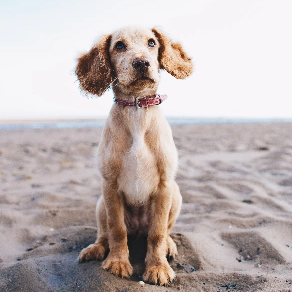
Wanneer overschakelen op hypoallergene hondenvoeding?
Sommige honden lijken voortdurend met hun gezondheid te sukkelen: jeuk, oorontstekingen, dunne ontlasting, doffe vacht of overgeven. Misschien herken je je viervoeter er wel in. Dan is de kans groot dat jouw hond last heeft van een voedselintolerantie of -allergie.
Gelukkig hoeft dit zijn leven niet te blijven bepalen. De juiste voeding brengt comfort, energie en levensplezier terug. Bij Delcon weten we hoeveel verschil de juiste voeding maakt. Net daarom doen we veel onderzoek naar hypoallergene voeding en breiden we ons assortiment steeds verder uit naar bijvoorbeeld hypoallergene voeding voor puppy’s, juniors en kleine rassen.
Het Delcon assortiment hypoallergene hondenvoeding
Voedselintoleranties en -allergieën herkennen: wat zijn de symptomen bij honden?
Voedselintolerantie of allergieën bij honden zijn zeker geen zeldzaamheid. Net zoals bij mensen reageert het lichaam van een hond soms overdreven op bepaalde stoffen. Dit kan leiden tot:
Jeuk en overmatig krabben,
Likken of bijten aan poten,
Een doffe of schilferige vacht
Verminderde eetlust of futloosheid
Terugkerende oorontstekingen,
Braken en/of diarree,
Gevoelige huid of huidproblemen
Deze klachten zijn niet enkel vervelend, ze tasten ook het algemene welzijn van je hond aan. Gelukkig maakt hypoallergene voeding vaak een wereld van verschil.
Hoe helpt hypoallergene voeding je hond?
Het Delcon assortiment hypoallergene voeding is speciaal ontwikkeld voor honden met een gevoelig spijsverteringsstelsel, intoleranties of allergieën. Door bepaalde ingrediënten bewust weg te laten en te werken met één zorgvuldig gekozen proteïnebron, vermijd je dat het immuunsysteem van je hond overprikkeld raakt.
Bij Delcon nemen we dit principe serieus. Onze Delcon Hypoallergenic lijn bevat per variant maar één dierlijke eiwitbron zoals lam of eend. Geen mengelingen of onverwachte toevoegingen, wél pure en zorgvuldig geselecteerde ingrediënten.
Daarnaast zijn al onze hypoallergene recepten ook:
Graanvrij
Rijk aan natuurlijke prebiotica (voor gezonde darmflora)
Vervaardigd met zoete aardappel (een goed verteerbare energiebron)
Vrij van kunstmatige kleur- of smaakstoffen
Als Belgisch kwaliteitsmerk kiezen we bovendien bewust voor lokale, hoogwaardige ingrediënten.
Eerst zien en dan geloven? Vraag je proefpakket hypoallergene voeding van Delcon aan en merk zelf de resultaten bij je hond.BESTEL HIER JOUW PROEFPAKKET
Nieuw: hypoallergene voeding voor puppy’s en kleine honden en een extra smaak
Ons gamma hypoallergene voeding werd recent uitgebreid. Naast de vertrouwde Hypoallergenic brokken voor volwassen honden, vind je nu ook varianten voor:
Pyppy's en junior: met aangepaste voedingswaarden en structuur voor jonge honden in volle groei.
Mini-honden: met kleinere brokjes, speciaal ontworpen voor kleine rassen met een gevoelig spijsverteringsstelsel.
Ook adult honden genieten mee want naast lam kunnen ze nu ook eend kiezen als favoriete hypoallergene brok.
Daarnaast zijn er ook hypoallergene snacks voor gevoelige snoepers. Ideaal als tussendoortje of beloning, zonder zorgen.
Waarom kiezen voor Delcon?
Eerst en vooral is Delcon een Belgisch merk met een duidelijke visie: hondenvoeding moet gezond, eerlijk en evenwichtig zijn. We werken daarvoor nauw samen met voedingsdeskundigen en baseren onze recepten op de noden van honden, niet op trends.
Dit maakt ons uniek in België:
Slechts één dierlijke eiwitbron per recept. Zo hou je grip op mogelijke triggers in de voeding van je hond.
Hypoallergene voeding voor alle leeftijden en groottes. Ook voor puppy's, juniors en kleine rassen.
Lokale productie met pure ingrediënten. We staan voor transparantie in elke brok.
Een persoonlijk aanspreekpunt. Onze klantendienst staat voor je klaar bij vragen over ons assortiment.
En het mooiste? Honden met klachten bloeien vaak helemaal open na een overstap naar onze hypoallergene brokken en snacks. Dat lezen we niet alleen in reviews, maar zien we dagelijks in onze community van tevreden baasjes.
Boule lust de hypoallergene voeding heel graag tegenover vorige merken. Hopelijk blijft dit zo en blijven reacties uit. Leefde al jaren op bijna enkel water en brood. R. Huysman
Dit is het enige voer dat alle 3 onze honden lusten. Geen darmproblemen meer en nu goede stoelgang. Top! V Van Der Zalm
Onze Golden Retriever Sky heeft een veel betere stoelgang sinds we Delcon kopen. De service is goed en snel. E. Laermans
Heel blij met jullie kwalitatieve voer! Onze Vizsla heeft eindelijk rustige darmen dankzij jullie hypoallergene eten! A. Fayard
De oplossing voor een betere levenskwaliteit van gevoelige honden
Een voedselintolerantie of -allergie hoeft het leven van je hond niet te bepalen. Met de juiste voeding geef je hem comfort en levensvreugde terug. Delcon helpt je daarbij, met hypoallergene recepten die eenvoudig, puur en Belgisch zijn.
Nieuwsgierig? Bekijk ons gamma online of vraag vandaag nog je proefpakket aan. Je hond is je nu al dankbaar!
Proefpakket online kopen
Verdeelpunten vinden